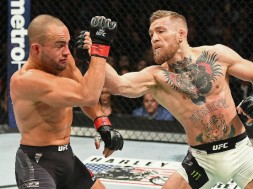Mixed Martial Arts has come a long way from its embryonic phase, starting from an 8-man tournament similar to gruesome combat movies like Bloodsport, to a recognized mainstream sport and serves as a home to true professional athletes all over the world. Mixed Martial Arts, or MMA as we call it, is a full contact sport that uses any combination of self-defense and offensive disciplines, using grappling and striking, and determine who is the best fighter on the planet. Some of the common striking disciplines used in MMA are Muay Thai, Kickboxing, Karate, and Boxing, among others. For the grappling arts, the more utilized styles include Brazilian Jiu-Jitsu, Wrestling, and Sambo.
Brazilian Jiu-Jitsu (BJJ) royalty Rorion Gracie brought the concept of the Ultimate Fighting Championship (UFC) in the United States in 1993, as a way to find out which martial art is most effective. Champions from different disciplines were invited to take part in the tournament, from Savate to Kickboxing, and even Sumo. In the end, Rorion’s younger brother Royce proved what his elder brother was trying to emphasize all along: Brazilian Jiu-Jitsu is the most effective martial art in the world. Royce’s brilliance inside the cage has displayed to other people how a scrawny, non-imposing fighter in a gi could beat up savages three weight classes larger than him. Back then, Royce Gracie was the Ultimate Fighter.
Charles Darwin said it best: It is not the strongest of the species that survives, nor the most intelligent, but rather the one most adaptable to change. As time went by, and a new set of rules were regulated to make MMA a legitimate sport, a new breed of fighters learned the art of BJJ, and used it to either attack or defend themselves from the grappling art. In 2000, Japanese superstar Kazushi Sakuraba exposed this flaw, as he dealt the once-invincible Gracie Family with successive defeats, culminated by his classic beatdown of Royce in the semifinals of Pride Grand Prix 2000. Sakuraba laid out a blueprint on how to defeat the legendary Gracie family, and others have followed suit. Though Sakuraba was the first to make the first family of BJJ look human, it was American Frank Shamrock who epitomized the first true Mixed Martial Artist. Shamrock, the former King of Pancrase and brother of UFC pioneer Ken Shamrock, was the first fighter to show how training in multiple disciplines, and combine striking and grappling, can bring you to the top. Frank proved back then how you must have a complete skill set in order to win in a No Holds Barred setting. He defeated top contender Tito Ortiz for the UFC Middleweight (now Light Heavyweight) Championship after running through 5 different opponents. Marco Ruas earlier introduced the Vale Tudo way of mixing striking and grappling, but Frank Shamrock was the first to gain in the modern era.
During the decade, different types of fighters emerged in the spotlight. The UFC was dominated by wrestlers, with fighters like Matt Hughes, Tito Ortiz, Randy Couture and Chuck Liddell all holding the title for a long time. In Japan’s Pride Fighting Championship, a more diverse group of fighters were recognized as top of the food chain. While Chute Boxe Vale Tudo standout Wanderlei Silva of Brazil held the Pride title from 2001 to 2007, other Pride fighters were given the same limelight during their glory years. They had BJJ heavyweight Antonio Rodrigo “Minotauro” Nogueira, Sambo legend Fedor Emelianenko, Kickboxer Mirko “Crocop” Filipovic, wrestler-turned-brawler Quinton “Rampage” Jackson, and Mauricio “Shogun” Rua, another Chute Boxe prodigy, battling out for Pride glory. Due to the back-and-forth conflict between the UFC and Pride back then, it was difficult to make cross-promotion matches to determine the baddest man on the planet. UFC President Dana White managed to add Chuck Liddell in the roster of the 2003 Pride Middleweight Grand Prix to set up an anticipated superfight with Wanderlei Silva, but Rampage derailed the hype train and spoiled the fun for MMA fans. After the UFC’s parent company Zuffa, LLC bought Pride FC from Dream Stage Entertainment in 2007, all the top fighters have converged in one organization, with potential superfights looming between fighters from both promotions.
After the acquisition, the UFC began a new era in fighting, with two elite fighters dominating the scene once again. French-Canadian Georges St-Pierre became the World Welterweight Champion, and Brazilian Anderson Silva won the Middleweight belt. St-Pierre’s career was mostly in the UFC, while Silva used to fight in Pride. Both are still the titleholders until present day, with different ways of dominance for either fighter. Nobody has come close to beating St-Pierre, winning 30 straight rounds since 2008. Silva has never lost in 14 fights inside the Octagon since his debut in 2006, and has finished 12 of them, winning in championship bouts 10 times, and counting. Silva brought a new level of excitement for mainstream fans with his flashy moves and elusive counter-attacks that left fellow fighters in awe. St-Pierre, on the other hand, showed why discipline, athleticism, intelligent approach, and continuous improvement and evolution in every aspect of the sport can only get you far.
Today, fighters possess more skills by cross-training in different camps. Improvement in leaps and bounds were more evident with coaches now incorporating strength and conditioning drills within their training, to develop power, quickness, agility and explosiveness. Critics have anointed current Light Heavyweight champion Jon “Bones” Jones as the prototype of a new breed of fighters, after seemingly looking unstoppable since he set foot in the cage at the age of 21. While he basks in his glory and success, time will tell if Jones’ style will be the new benchmark in what a fighter should be like, just like how his predecessors paved the way to create the real Ultimate Fighter.





